Charles Rennie Mackintosh Glasgow School of Art Scotland 18971909
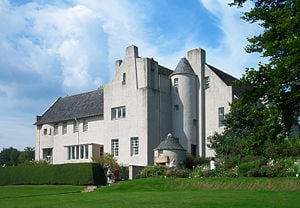
Charles Rennie Mackintosh (June seven, 1868 – December x, 1928) was a Scottish architect, designer, and watercolorist who was a designer in the Arts and Crafts motion and also the chief exponent of Fine art Nouveau in Scotland. Mackintosh began an apprenticeship with an architect at the age of sixteen, during which he attended evening classes in art at the Glasgow Schoolhouse of Art, where he met his future wife, Margaret MacDonald, her sister Frances MacDonald, and Herbert MacNair. Known equally "The Iv," they exhibited their works in Glasgow, London and Vienna. Mackintosh adult his ain architectural style, a contrast between strong right angles and floral-inspired decorative motifs with subtle curves, axiomatic in works such as the Mackintosh Rose motif. Although moderately pop (for a flow) in his native Scotland, nigh of his more than ambitious designs were not built. His most famous works are the Glasgow School of Fine art (1897-1909) building (now renamed "The Mackintosh Building"), regularly cited by architectural critics as among the very finest buildings in the UK, and the "Art Lover's House."
Contents
- 1 Life
- ii Architectural Piece of work: House for an Art Lover
- 2.one In the UK
- two.2 Unbuilt Mackintosh
- 3 Design Work and Paintings
- 4 Retrospect
- 5 See besides
- half dozen References
- vii External links
- 8 Credits
Later in life, disillusioned with architecture, Mackintosh worked largely every bit a watercolorist, painting numerous landscapes and blossom studies, often in collaboration with his wife Margaret. He was interested in the relationships betwixt man-made and naturally occurring landscapes.
Life
Charles Rennie Macintosh was born June 7, 1868, in Glasgow, Scotland, and attended the Allan Glen's Schoolhouse in Scotland. At the age of 16 he was apprenticed to an architect named John Hutchison and worked under him from 1884 until 1889. Around the time of Mackintosh's apprenticeship, he became a draftsman for a new architectural practice chosen Honeyman and Keppie and, in 1901, he joined the practice. During his apprenticeship, Mackintosh attended evening classes in art at the Glasgow School of Fine art. Information technology was at these classes that he first met Margaret MacDonald (whom he later married), her sister Frances MacDonald, and Herbert MacNair, a young man amateur with Mackintosh at Honeyman and Keppie. The group of artists, known as "The Four," exhibited in Glasgow, London and Vienna; these exhibitions helped establish Mackintosh's reputation. The so-called "Glasgow" style was exhibited in Europe and influenced the Viennese Art Nouveau move known as Sezessionstil (in English, The Secession) effectually 1900.
Rennie joined a firm of architects in 1889 and adult his own fashion: a contrast between strong right angles and floral-inspired decorative motifs with subtle curves, such as the Mackintosh Rose motif, along with some references to traditional Scottish architecture. The project that helped make his international reputation was the Glasgow School of Art (1897-1909).
He died in 1928 of throat cancer.
Architectural Work: House for an Art Lover
The Firm for an Art Lover is based on a concept blueprint produced in 1901 by Charles Rennie Mackintosh with his married woman, Margaret MacDonald. The building is situated in Bellahouston Park in Glasgow, Scotland. Structure began in 1989 and the business firm was finally opened to the public in 1996. Mackintosh's original designs were interpreted and realized by John Kane and Graeme Robertson (up to 1990) nether Andrew MacMillan, with contributions by many contemporary artists. Original portfolio designs are displayed in each room to permit comparisons.
The business firm was originally designed for an ideas competition set by the German design magazine Zeitschrift für Innendekoration for a "Haus eines Kunstfreundes" (Fine art Lover'southward House). Despite disqualification due to late entry, the portfolio was awarded a prize for "pronounced personal quality, novel and austere class and the uniform configuration of interior and outside."
In the UK
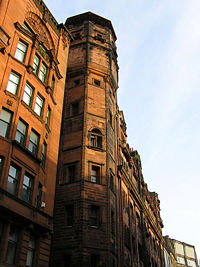
"The Lighthouse," Charles Mackintosh's Glasgow Herald building
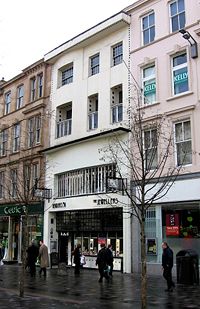
The Willow Tearooms in Sauchiehall Street
Amongst his noted architectural works are:
- Windyhill, Kilmacolm
- Hill House, Helensburgh (National Trust for Scotland)
- House for an Art Lover, Glasgow
- The Mackintosh Business firm (interior design, reconstructed with original piece of furniture and fitments at the Hunterian Museum and Art Gallery, Glasgow)
- Queen's Cross Church, Glasgow
- Ruchill Church Hall, Glasgow
- Holy Trinity Church, Bridge of Allan, Stirling
- Scotland Street School, Glasgow, at present Scotland Street School Museum.
- The Willow Tearooms, Sauchiehall Street, Glasgow; i of Miss Cranston's Tearooms: meet Catherine Cranston for his interior design piece of work on her other tea rooms
- Hous'hill, interior design of the home of Catherine Cranston and her husband John Cochrane (demolished, article of furniture in collections)
- Glasgow Schoolhouse of Art, Glasgow
- Craigie Hall, Glasgow
- Martyrs' Public School, Glasgow
- The Royal Highland Fusiliers Museum, Glasgow
- Former Daily Record offices, Glasgow
- One-time Glasgow Herald offices in Mitchell Street, now The Lighthouse - Scotland's Centre for Architecture, Design and the City
- 78 Derngate, Northampton (interior pattern for Wenman Joseph Bassett-Lowke, founder of Bassett-Lowke)
- 5 The Drive, Northampton (for Bassett-Lowke's brother-in-law)
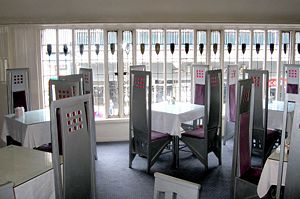
The Room de Luxe at The Willow Tearooms features furniture and interior design by Mackintosh and Margaret Macdonald.
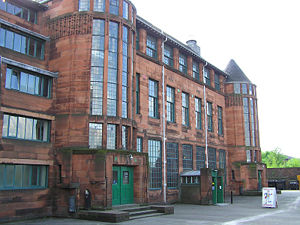
Scotland Street schoolhouse in Glasgow
Unbuilt Mackintosh
Although moderately pop (for a period) in his native Scotland, almost of his more ambitious designs were not built. His designs of various buildings for the 1901 Glasgow International Exhibition were not constructed, every bit was his "Haus eines Kunstfreundes" (Fine art Lover's House) in the aforementioned twelvemonth. He competed in the 1903 pattern competition for Liverpool Cathedral, just lost the commission to Giles Gilbert Scott.
Although the Business firm for An Fine art Lover was subsequently (1989-1996) congenital after his decease, Mackintosh left many unbuilt designs.
- Railway Terminus,
- Concert Hall,
- Alternative Concert Hall,
- Bar and Dining Room,
- Exhibition Hall
- Scientific discipline and Art Museum
- Affiliate House
- Liverpool Cathedral - Anglican Cathedral contest entry
Although Mackintosh's architectural output was adequately small he had a considerable influence on European design. Especially pop in Republic of austria and Frg, Mackintosh'south work was highly acclaimed when it was shown at the Vienna Secession Exhibition in 1900. It was also exhibited in Budapest, Munich, Dresden, Venice and Moscow.
Pattern Work and Paintings
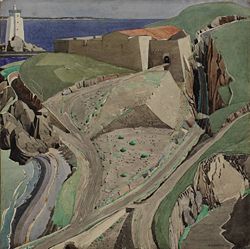
The Fort, circa 1925 - 1926. Fort Mailly, a ruined sixteenth-century fortification on the outskirts of Port Vendres.
Mackintosh too worked in interior pattern, furniture, textiles and, metalwork. Much of this work combines Mackintosh's own designs with those of his wife, whose flowing, floral style complimented his more than formal, rectilinear work. Similar his contemporary Frank Lloyd Wright, Mackintosh's architectural designs oft included all-encompassing specifications for the detailing, ornament, and furnishing of his buildings. His work was shown at the Vienna Secession Exhibition in 1900.
Later in life, disillusioned with compages, Mackintosh worked largely every bit a watercolorist, painting numerous landscapes and bloom studies (often in collaboration with Margaret, with whose manner Mackintosh's own gradually converged) in the Suffolk village of Walberswick (to which the pair moved in 1914). By 1923, he had entirely abandoned architecture and design and moved to the s of France with Margaret where he concentrated on watercolor painting. He was interested in the relationships between homo-made and naturally occurring landscapes. Many of his paintings describe Port Vendres, a modest port near the Spanish border, and the nearby landscapes.
Hindsight
Mackintosh's designs gained in popularity in the decades following his decease. His Firm for an Fine art Lover was finally congenital in Glasgow'due south Bellahouston Park in 1996, and the Academy of Glasgow (which owns the majority of his watercolor work) rebuilt a terraced house Mackintosh had designed, and furnished it with his and Margaret's work (it is part of the University's Hunterian Museum). The Glasgow School of Art edifice (now renamed "The Mackintosh Building") is regularly cited past architectural critics as among the very finest buildings in the UK. The Charles Rennie Mackintosh Social club tries to encourage a greater awareness of the work of Mackintosh as an important architect, artist and designer.
See also
- Glasgow
- Culture in Glasgow
References
ISBN links support NWE through referral fees
- Billcliffe, Roger. 1979. Charles Rennie Mackintosh the complete furniture, furniture drawings & interior designs. New York: Taplinger Pub. Co. ISBN 0800817737
- Crawford, Alan. 1995. Charles Rennie Mackintosh. World of fine art. New York: Thames and Hudson. ISBN 0500202834
- Davidson, Fiona. 1998. The Pitkin Guide: Charles Rennie Mackintosh. Slap-up Great britain: Pitkin Unichrome. ISBN iii-8228-3204-nine
- Fiell, Charlotte and Peter. 1995. Charles Rennie Mackintosh. Taschen. ISBN 3-8228-3204-ix
- Mackintosh, Charles Rennie, and Wendy Kaplan. 1996. Charles Rennie Mackintosh. Glasgow: Glasgow Museums. ISBN 1558597913
External links
All links retrieved February 6, 2017.
- Charles Rennie Mackintosh Society Glasgow, Scotland
- Mackintosh Online Searchable online catalog with over one thousand images - the globe's largest collection of Mackintosh works from the Hunterian Museum and Art Gallery, University of Glasgow, Scotland.
- Charles Rennie Mackintosh Pictorial History
- Charles Rennie Mackintosh at the archINFORM database.
Credits
New World Encyclopedia writers and editors rewrote and completed the Wikipedia commodity in accordance with New Earth Encyclopedia standards. This article abides by terms of the Creative Eatables CC-by-sa 3.0 License (CC-by-sa), which may be used and disseminated with proper attribution. Credit is due under the terms of this license that can reference both the New Globe Encyclopedia contributors and the selfless volunteer contributors of the Wikimedia Foundation. To cite this article click hither for a listing of acceptable citing formats.The history of earlier contributions past wikipedians is attainable to researchers here:
- Charles Rennie Mackintosh history
The history of this article since information technology was imported to New Globe Encyclopedia:
- History of "Charles Rennie Mackintosh"
Note: Some restrictions may apply to use of individual images which are separately licensed.
Source: https://www.newworldencyclopedia.org/entry/Charles_Rennie_Mackintosh
0 Response to "Charles Rennie Mackintosh Glasgow School of Art Scotland 18971909"
Postar um comentário